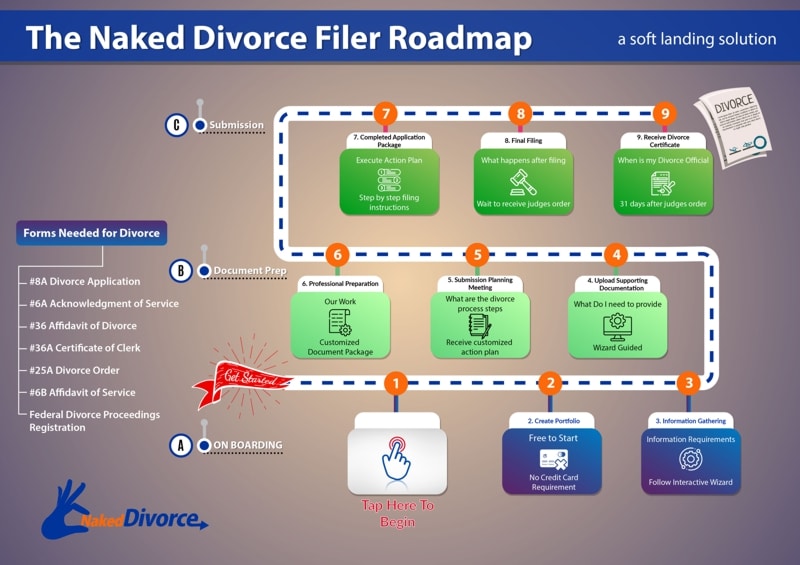Divorce can feel overwhelming, especially when you’re trying to understand how long the process will take and what to expect along the way. If you’re considering divorce in Ontario, you’re likely wondering about the divorce timeline Ontario residents experience and how to navigate the process without unnecessary delays or complications.
The good news is that with proper planning and understanding of the system, many couples can complete their divorce efficiently. Whether you’re in a rural community or an urban center like Toronto, understanding the timeline can help you prepare emotionally, financially, and practically for what lies ahead.
In this comprehensive guide, we’ll walk you through everything you need to know about the divorce timeline in Ontario, from the initial filing to the final divorce order, and provide practical tips to help you avoid common pitfalls that can extend the process unnecessarily.
The Divorce Timeline in Ontario: What to Expect
Understanding Different Timeline Scenarios
The divorce timeline in Ontario varies significantly based on your specific circumstances, location, and the complexity of your case. For those pursuing an uncontested divorce—where both parties agree on major issues such as property division, child custody, and spousal support—the process is generally much faster and more straightforward.
Rural vs Urban Processing Times:
- Rural settings: 3-4 months for uncontested divorces
- Urban centers: 4-6 months for uncontested divorces
The difference in processing times often comes down to court availability and caseload. Rural courts typically handle fewer cases, which can result in faster processing, while urban courts in cities like Toronto, Ottawa, and Hamilton may experience higher volumes and slightly longer wait times.
Why Uncontested Divorce is the Fastest Option
An uncontested divorce in Ontario represents the most efficient path to legally ending your marriage. The divorce process in Canada works when both spouses can reach agreements on all major issues without requiring court intervention to resolve disputes. The streamlined nature of uncontested divorces eliminates the need for lengthy court battles, multiple hearings, and extensive legal proceedings.
The key advantage of choosing this route is not just the shortened timeline, but also the reduced emotional stress and financial burden on both parties and any children involved.
The Ontario Divorce Process: Step-by-Step Timeline
Step 1: Meeting the Basic Requirements
Before diving into the divorce timeline Ontario courts follow, it’s essential to understand the basic requirements you must meet:
Legal Requirements:
- You must be legally married under Canadian law, or your marriage must be recognized in Canada
- The marriage must have broken down irretrievably
- Either you or your spouse must have lived in Ontario for at least one year before filing
Separation Requirement: The most important requirement affecting your timeline is the mandatory separation period. In Ontario, couples must be separated for at least one year before a divorce can be finalized, except in cases involving adultery or cruelty. This separation period begins from the day you officially separate, even if you continue living under the same roof due to financial constraints.
Interestingly, you can actually file your divorce application before the full year of separation is complete, which can help expedite the overall process once the separation period requirement is met.
Step 2: Document Preparation and Filing (1-2 weeks)
The first active step in your divorce timeline involves gathering and preparing all necessary documentation. This includes:
- Divorce application forms
- Original marriage certificate
- Any separation agreements
- Financial disclosure documents
- Child custody and support agreements (if applicable)
Filing Options: You can file your divorce application either in person at the Ontario Superior Court of Justice or through Ontario’s online divorce services. The online option has become increasingly popular as it offers convenience and can slightly expedite the process.
During this phase, attention to detail is crucial. Even minor errors in your paperwork can result in delays that extend your timeline by weeks or even months.
Step 3: Court Review and Processing (2-4 months)
Once your application is submitted, the court begins its review process. This is typically the longest portion of the divorce timeline Ontario residents experience, and several factors can influence how long this stage takes:
Factors Affecting Review Time:
- Completeness and accuracy of submitted documents
- Current court caseload and availability
- Whether additional information or clarification is needed
- Geographic location (rural vs urban courts)
During this period, the court reviews all documentation to ensure everything is in order and that all legal requirements have been met. If there are any issues with your paperwork, the court will request additional information, which can add several weeks to your timeline.
Step 4: Final Divorce Order and 31-Day Waiting Period
After the court approves your divorce application, a final divorce order is granted. However, this order doesn’t take effect immediately. There’s a mandatory 31-day waiting period before your divorce becomes final. This waiting period is built into the divorce timeline Ontario courts follow and allows time for any potential appeals.
Once this 31-day period expires, your divorce is officially complete, and you’re legally free to remarry if you choose.
Factors That Can Slow Down Your Divorce Timeline
Common Delays and How They Impact Your Timeline
Understanding what can slow down the divorce process helps you avoid these pitfalls and maintain a reasonable timeline for your divorce.
Missing or Incomplete Documentation: One of the most frequent causes of delays involves submitting incomplete or incorrect forms. When the court identifies missing information or errors, they’ll request corrections, which can add weeks or months to your timeline. Double-checking all paperwork before submission is one of the simplest ways to avoid these delays.
Service of Divorce Papers: Properly serving divorce papers to your spouse is a mandatory legal requirement. If your spouse is difficult to locate, uncooperative, or if there are issues with the service process, this can significantly impact your timeline. Planning ahead and understanding the service requirements can help prevent these delays.
Court Backlogs and Administrative Delays: Court availability varies throughout Ontario, and administrative delays are sometimes unavoidable. These are factors largely outside your control, but understanding they exist helps set realistic expectations for your divorce timeline.
Complex Financial or Custody Issues: Even in uncontested divorces, complex financial arrangements or detailed custody agreements can require additional review time, potentially extending your timeline.
How to Expedite Your Divorce Process
Ensuring Accurate and Complete Documentation
The most effective way to maintain a smooth divorce timeline is to ensure all your paperwork is accurate and complete from the start. This means:
- Carefully reviewing all forms before submission
- Ensuring all required signatures are in place
- Attaching all necessary supporting documents
- Double-checking dates, names, and financial information
The Role of Professional Support
Working with a Certified Divorce Specialist (CDS): A Certified Divorce Specialist can be invaluable in navigating the divorce timeline Ontario courts require. These professionals specialize in divorce documentation and process management, helping you avoid common mistakes that can delay your case.
A CDS can assist with:
- Document preparation and review
- Filing procedures and requirements
- Timeline management and expectations
- Communication with court officials
- Integration with services like the Naked Divorce Filer for streamlined processing
When Professional Help Makes Sense: While not every divorce requires professional assistance, consulting with a CDS can be particularly beneficial if:
- You want to minimize the risk of delays
- Your case involves complex financial or custody arrangements
- You’re unfamiliar with legal procedures
- You want peace of mind that everything is handled correctly
The investment in professional support often pays for itself by preventing costly delays and ensuring your divorce proceeds as quickly as possible.
Utilizing Available Resources and Tools
Digital Filing and Online Resources: Ontario offers various online tools and resources that can help streamline your divorce process:
- Online divorce application systems
- Digital document submission options
- Electronic communication with court offices
- Online status tracking for your case
Staying Organized: Maintaining organization throughout your divorce process is crucial for avoiding delays. Consider using:
- Divorce preparation checklists
- Document tracking systems
- Calendar reminders for important deadlines
- Secure storage for all divorce-related paperwork
Special Considerations for Ontario Residents
Understanding Separation Period Rules
The one-year separation requirement is often misunderstood and can impact your overall timeline if not handled correctly. Key points to remember:
- Separation can occur while living in the same home under certain circumstances
- The separation period begins from the date you decide the marriage is over
- Brief reconciliation attempts (up to 90 days total) don’t restart the separation clock
- You can file your divorce application before the year is complete
Geographic Considerations
Your location within Ontario can affect your divorce timeline:
Rural Areas:
- Generally faster processing (3-4 months)
- Fewer cases in the queue
- More personalized service
- Potentially easier access to court staff
Urban Centers:
- Standard processing time (4-6 months)
- Higher case volumes
- More resources and services available
- Greater access to professional support services
Avoiding Common Mistakes That Extend Your Timeline
Documentation Errors
Pay careful attention to:
- Correct legal names and spellings
- Accurate dates and addresses
- Complete financial disclosures
- Proper notarization where required
Process Misunderstandings
Common misconceptions that can delay your divorce include:
- Misunderstanding separation period requirements
- Incorrectly assuming certain agreements are legally binding
- Failing to understand service requirements
- Not accounting for the 31-day waiting period in planning
Communication Issues
Maintaining clear communication with:
- Your spouse (in uncontested divorces)
- Court officials
- Any professional support team
- Your Certified Divorce Specialist or service provider
The Complete Timeline: From Start to Finish
Typical Uncontested Divorce Timeline in Ontario
Phase 1: Preparation (1-2 weeks)
- Gather required documents
- Complete divorce application
- Review for accuracy and completeness
Phase 2: Filing and Initial Processing (1-2 weeks)
- Submit application to court
- Pay required fees
- Receive initial acknowledgment
Phase 3: Court Review (2-4 months)
- Court reviews application and supporting documents
- May request additional information if needed
- Processing varies by location (rural: 2-3 months, urban: 3-4 months)
Phase 4: Final Order and Waiting Period (31 days)
- Receive divorce order
- Mandatory 31-day waiting period
- Divorce becomes final
Total Timeline: 3-6 months depending on your location and case complexity.
Factors That Can Accelerate Your Timeline
Several strategies can help you achieve the shorter end of the timeline range:
- Professional Support: Working with a CDS and utilizing services like the Naked Divorce Filer
- Preparation: Having all documents ready before filing
- Location: Filing in areas with lower court backlogs
- Cooperation: Maintaining good communication with your spouse in uncontested cases
- Technology: Using online filing options where available
Moving Forward with Confidence
Understanding the divorce timeline Ontario courts follow helps you plan effectively and set realistic expectations for your divorce process. While the legal end of a marriage is never easy emotionally, having a clear roadmap can reduce stress and help you focus on building your new life.
Remember that every divorce case is unique, and your specific timeline may vary based on your circumstances. The key is to be prepared, stay organized, and consider professional support when it makes sense for your situation.
Whether contemplating divorce or ready to start, understanding Canadian divorce proceedings empowers you to make informed decisions about your future. With proper planning and the right support, you can navigate this challenging time efficiently and move forward with confidence toward the next chapter of your life.


















































